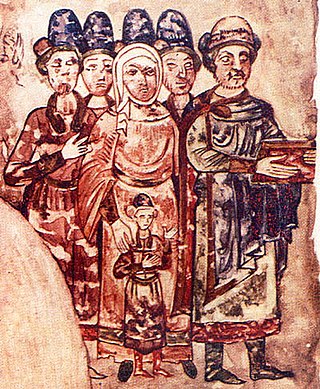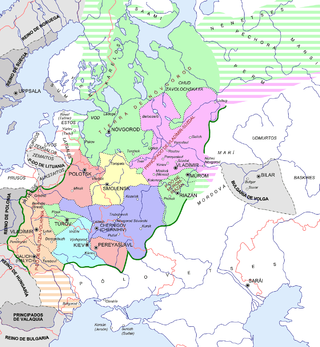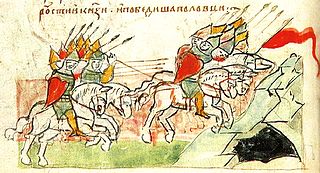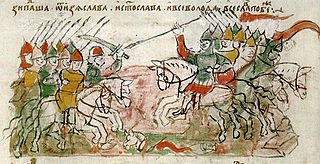Related Research Articles

Vsevolod I Yaroslavich was Grand Prince of Kiev from 1078 until his death in 1093.

Iziaslav Yaroslavich was Prince of Turov and Grand Prince of Kiev.

Sviatoslav II Iaroslavich or Sviatoslav II Yaroslavich was Grand Prince of Kiev from 1073 until his death in 1076. He was a younger son of Yaroslav the Wise, the grand prince of Kiev. He is the progenitor of the Sviatoslavichi branch of Rurikids.

Vseslav Bryachislavich was Prince of Polotsk (1044–1101) and Grand Prince of Kiev (1068–1069). Together with Rostislav Vladimirovich and voivode Vyshata, he created a coalition against the Yaroslaviches' triumvirate. Polotsk's Cathedral of Holy Wisdom, completed in the mid-11th century, is one of the most enduring monuments from his reign and the oldest stone building in Belarus.

The Principality of Polotsk, also known as the Duchy of Polotsk or Polotskian Rus', was a medieval principality. The origin and date of the establishment of the state are uncertain. Chronicles of Kievan Rus' mention Polotsk being conquered by Vladimir the Great, and thereafter it became associated with Kievan Rus' and its ruling Rurik dynasty.
Rostislav Vladimirovich was a landless prince (izgoi) from the Rurikid dynasty of Kievan Rus’. He was baptized as Mikhail. According to the Russian genealogist Nikolai Baumgarten, the mother of Rostislav was Oda of Stade, a daughter of the Stade Count Leopold. That claim is also supported by other historians.

The inner Principality of Kiev was a medieval principality centered on the city of Kiev.

Iziaslav Vladimirovich (978–1001) was the son of Vladimir I of Kiev and Rogneda of Polotsk. He was the progenitor of the Polotsk branch of Rurikid princes known as the Iziaslavichi.

The Battle of Alta River was a 1068 clash on the Alta River between Cuman army on the one hand and Kievan Rus' forces of Grand Prince Iziaslav I of Kiev, Prince Sviatoslav of Chernigov, and Prince Vsevolod of Periaslavl on the other in which the Rus' forces were routed and fled back to Kiev and Chernigov in some disarray. The battle led to an uprising in Kiev that briefly deposed Grand Prince Iziaslav. That incident supposedly shows the power of the Kiev veche and how common people gathering influenced princely politics in Kievan Rus'.
Bryachislav Iziaslavich was the prince of Polotsk between 1001 and 1044. His name, possibly, may have been of something in approximation to Vratislav or Wroclaw. He was son of Iziaslav of Polotsk. During his reign Polotsk was at war with Kiev and Novgorod. In 1015 he inherited the city of Lutsk after the death of his grandfather Vladimir I of Kiev.
The Kiev uprising of 1068 was a revolt against Grand Prince Iziaslav Yaroslavich of Kiev in the aftermath of a Kievan Rus’ defeat at the hands of the Cumans at Battle of the Alta River near the city of Pereiaslavl, southeast of Kiev.
The rotasystem or the lestvitsa system is a historiographical concept introduced by historian Sergei Soloviev in 1860, attempting to describe a system of collateral succession practiced in Kievan Rus', later appanages, and early the Principality of Moscow. In this system, the throne passed not linearly from father to son, but laterally from brother to brother and then to the eldest son of the eldest brother who had held the throne.
The Prince of Pereyaslavl was the ruler of the Principality of Pereyaslavl, a lordship based on the city of Pereyaslavl on the Trubizh River, and straddling extensive territory to the east in what are now parts of Ukraine. It was situated on the southern frontier of Kievan Rus' and bordered the steppe.

The Principality of Smolensk was a Kievan Rus' lordship from the 11th to the 16th century. Until 1127, when it passed to Rostislav Mstislavich, the principality was part of the land of Kiev. The principality gradually came under Lithuanian influence and was incorporated into the Grand Duchy of Lithuania in 1404. The principality was reorganized into the Smolensk Voivodeship in 1508. The Principality of Moscow controlled the city from 1514 to 1611, then it was recaptured by the Polish–Lithuanian Commonwealth. Tsardom of Russia recaptured the city in 1654.
The Prince of Polotsk ruled the Principality of Polotsk within the realm of Kievan Rus' or within the Grand Duchy of Lithuania from the mid-9th century to 1307.

Yaropolk Iziaslavich was Prince of Turov and Prince of Volhynia from 1078 until his death.

The Battle on the Nemiga River was a battle of the Kievan Rus' feudal period that occurred on March 3, 1067 on the Niamiha River. The description of the battle is the first reference to Minsk in the chronicles of Belarusian history.

The Rurik dynasty, also known as the Rurikid or Riurikid dynasty, as well as simply Rurikids or Riurikids, was a noble lineage allegedly founded by the Varangian prince Rurik, who, according to tradition, established himself at Novgorod in the year 862. The Rurikids were the ruling dynasty of Kievan Rus' and its principalities following its disintegration.

The sack of Kiev took place on 8–12 March 1169 when a coalition of 11 princes, assembled by prince Andrey Bogolyubsky of Vladimir-Suzdal, attacked the Kievan Rus' capital city of Kiev during the 1167–1169 Kievan succession crisis. The conflict, caused by the death of grand prince Rostislav I of Kiev, was between rival branches of the Monomakhovichi clan: the Iziaslavichi of Volhynia on the one hand, and the Rostislavichi of Smolensk, the Yurievichi, and the Olgovichi of Chernigov on the other. Prince Mstislav II of Kiev sought to defend Kiev against the Rostislavichi–Yurievichi–Olgovichi coalition.

The Rostislavichi of Smolensk were one of the four dominant princely clans of Kievan Rus' in the 12th and 13th century. They were one of many branches of the House of Rurik.
References
- ↑ Dimnik, Martin (2006), Perrie, Maureen (ed.), "The Rus' principalities (1125–1246)", The Cambridge History of Russia: Volume 1: From Early Rus' to 1689, The Cambridge History of Russia, vol. 1, Cambridge: Cambridge University Press, pp. 98–126, ISBN 978-1-139-05410-2 , retrieved 2023-03-21
- ↑ Sergei Soloviev, Istorii Rossii s drevneishchikh vremen. 29 volumes in 15 books, vol. 1 (Moscow: Izdatel'stvo sotsial'no-ekonomicheskoi literatury, 1960), 346-348.
- ↑ A. D. Stokes, “the System of Succession to the Thrones of Russia, 1054-1113,” in R. Auty, L. R. Lewitter, and A. P. Vlasto, eds., Gorski Vijenats: A Garland of Essays Offered to Professor Elizabeth Mary Hill (Cambridge: Modern Humanities Research Association, 1970): 268-275.
- ↑ Kollmann, Nancy Shields (1990). "Collateral Succession in Kievan Rus'". Harvard Ukrainian Studies. 14: 377–387.
- ↑ Janet Martin, Medieval Russia 980-1584 (Cambridge: Cambridge University Press, 1995), 26-29.
- ↑ Russkaia Pravda, Expanded Version, art. 1.
- ↑ Martin, Medieval Russia, 29.
- ↑ Martin, Medieval Russia,96